Validation of Landsat-9 and Landsat-8 Surface Temperature and Reflectance during the Underfly Event
Abstract
1. Introduction
2. Methodologies
2.1. Ground Instrumentation
2.1.1. Designs and Prototypes (D&P) FTIR
2.1.2. Onset HOBO TidBit Temperature Loggers
2.1.3. Spectra Vista Corporation (SVC) Spectroradiometer
2.2. UAS-Based Instrumentation
3. Results and Discussions
3.1. The Underfly Event
3.2. TIRS-2 Performance since Launch
4. Conclusions and Summary
Author Contributions
Funding
Data Availability Statement
Conflicts of Interest
References
- Kaita, E.; Markham, B.; Haque, M.O.; Dichmann, D.; Gerace, A.; Leigh, L.; Good, S.; Schmidt, M.; Crawford, C.J. Landsat 9 Cross Calibration Under-Fly of Landsat 8: Planning, and Execution. Remote Sens. 2022, 14, 5414. [Google Scholar] [CrossRef]
- Gerace, A.; Eon, R.; Kleynhans, T.; Raqueño, N.; Webber, C.M.; Ely, P.; Ventresco, S. In-flight performance of the Multi-band Uncooled Radiometer Instrument (MURI) thermal sensor. Remote Sens. Environ. 2022, 279, 113086. [Google Scholar] [CrossRef]
- Eon, R.S.; Bachmann, C.M. Mapping barrier island soil moisture using a radiative transfer model of hyperspectral imagery from an unmanned aerial system. Sci. Rep. 2021, 11, 3270. [Google Scholar] [CrossRef] [PubMed]
- Kaputa, D.S.; Bauch, T.; Roberts, C.; McKeown, D.; Foote, M.; Salvaggio, C. Mx-1: A new multi-modal remote sensing UAS payload with high accuracy GPS and IMU. In Proceedings of the 2019 IEEE Systems and Technologies for Remote Sensing Applications Through Unmanned Aerial Systems (STRATUS), Rochester, NY, USA, 25–27 February 2019; IEEE: Piscataway, NJ, USA, 2019; pp. 1–4. [Google Scholar]
- Helder, D.; Thome, K.J.; Mishra, N.; Chander, G.; Xiong, X.; Angal, A.; Choi, T. Absolute radiometric calibration of Landsat using a pseudo invariant calibration site. IEEE Trans. Geosci. Remote Sens. 2013, 51, 1360–1369. [Google Scholar] [CrossRef]
- Eon, R.S.; Bachmann, C.M.; Gerace, A.D. Retrieval of sediment fill factor by inversion of a modified Hapke model applied to sampled HCRF from airborne and satellite imagery. Remote Sens. 2018, 10, 1758. [Google Scholar] [CrossRef]
- HOBO MX2204 Data Logger. 2021. Available online: https://www.onsetcomp.com/datasheet/MX2204 (accessed on 1 April 2022).
- Pearlman, A.; Efremova, B.; Montanaro, M.; Lunsford, A.; Reuter, D.; McCorkel, J. Landsat 9 Thermal Infrared Sensor 2 On-Orbit Calibration and Initial Performance. IEEE Trans. Geosci. Remote Sens. 2022, 60, 1–8. [Google Scholar] [CrossRef]
- Gillespie, A.; Rokugawa, S.; Matsunaga, T.; Cothern, J.S.; Hook, S.; Kahle, A.B. A temperature and emissivity separation algorithm for Advanced Spaceborne Thermal Emission and Reflection Radiometer (ASTER) images. IEEE Trans. Geosci. Remote Sens. 1998, 36, 1113–1126. [Google Scholar] [CrossRef]
- Masuda, K.; Takashima, T.; Takayama, Y. Emissivity of pure and sea waters for the model sea surface in the infrared window regions. Remote Sens. Environ. 1988, 24, 313–329. [Google Scholar] [CrossRef]
- Gerace, A.; Kleynhans, T.; Eon, R.; Montanaro, M. Towards an operational, split window-derived surface temperature product for the thermal infrared sensors onboard Landsat 8 and 9. Remote Sens. 2020, 12, 224. [Google Scholar] [CrossRef]
- Smith, G.M.; Milton, E.J. The use of the empirical line method to calibrate remotely sensed data to reflectance. Int. J. Remote Sens. 1999, 20, 2653–2662. [Google Scholar] [CrossRef]
- Eon, R.S. The Characterization of Earth Sediments Using Radiative Transfer Models from Directional Hyperspectral Reflectance; Rochester Institute of Technology: Rochester, NY, USA, 2019. [Google Scholar]
- National Data Buoy Center. Available online: https://www.ndbc.noaa.gov/ (accessed on 22 October 2019).
- Padula, F.P. Historic Thermal Calibration of Landsat 5 TM through an Improved Physics Based Approach; Rochester Institute of Technology: Rochester, NY, USA, 2008. [Google Scholar]
- Gross, G.; Helder, D.; Begeman, C.; Leigh, L.; Kaewmanee, M.; Shah, R. Initial Cross-Calibration of Landsat 8 and Landsat 9 Using the Simultaneous Underfly Event. Remote Sens. 2022, 14, 2418. [Google Scholar] [CrossRef]
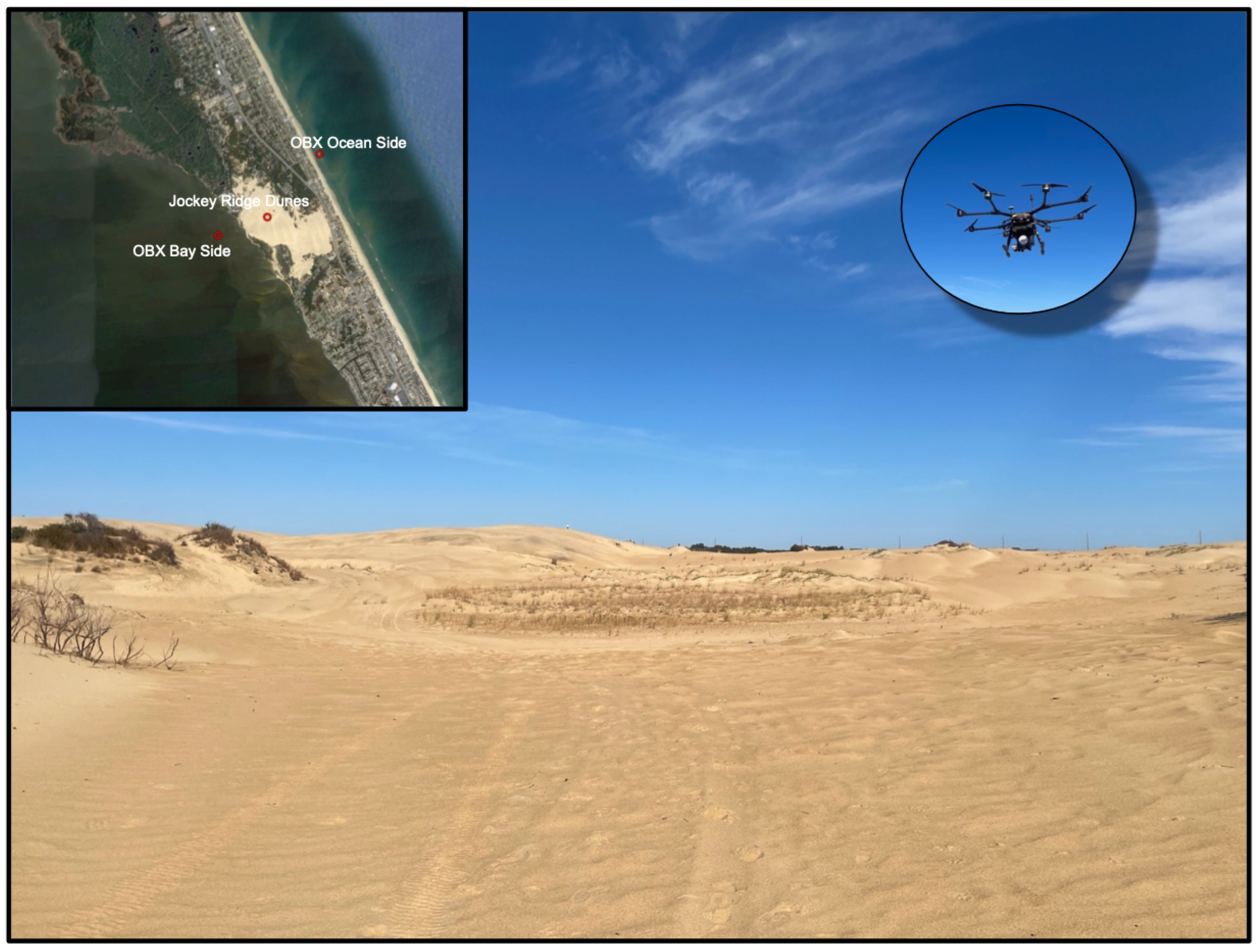


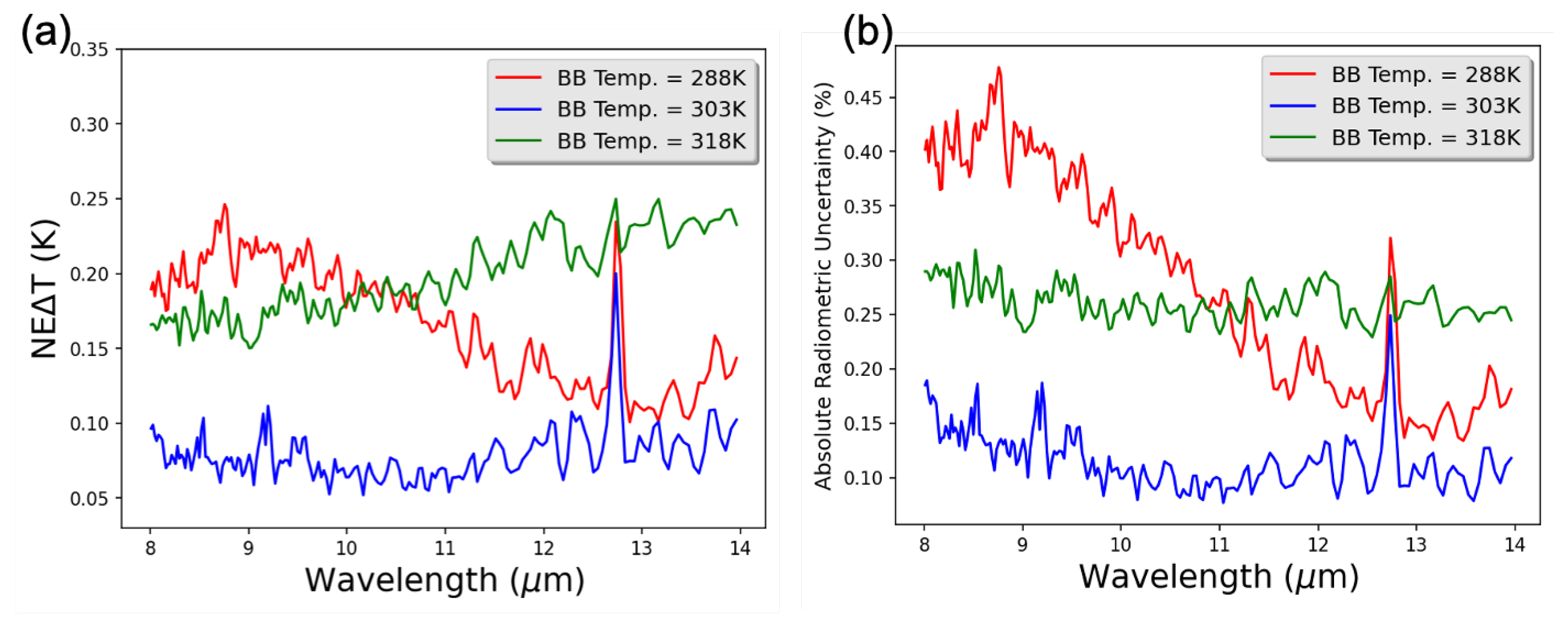

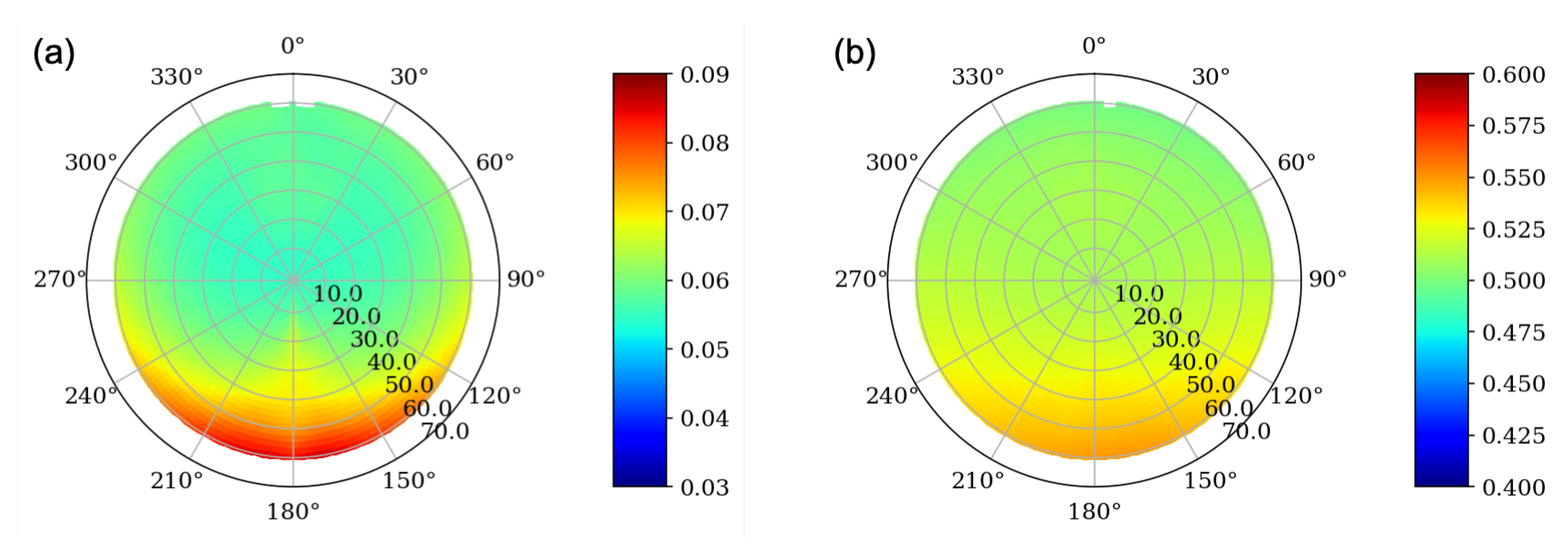
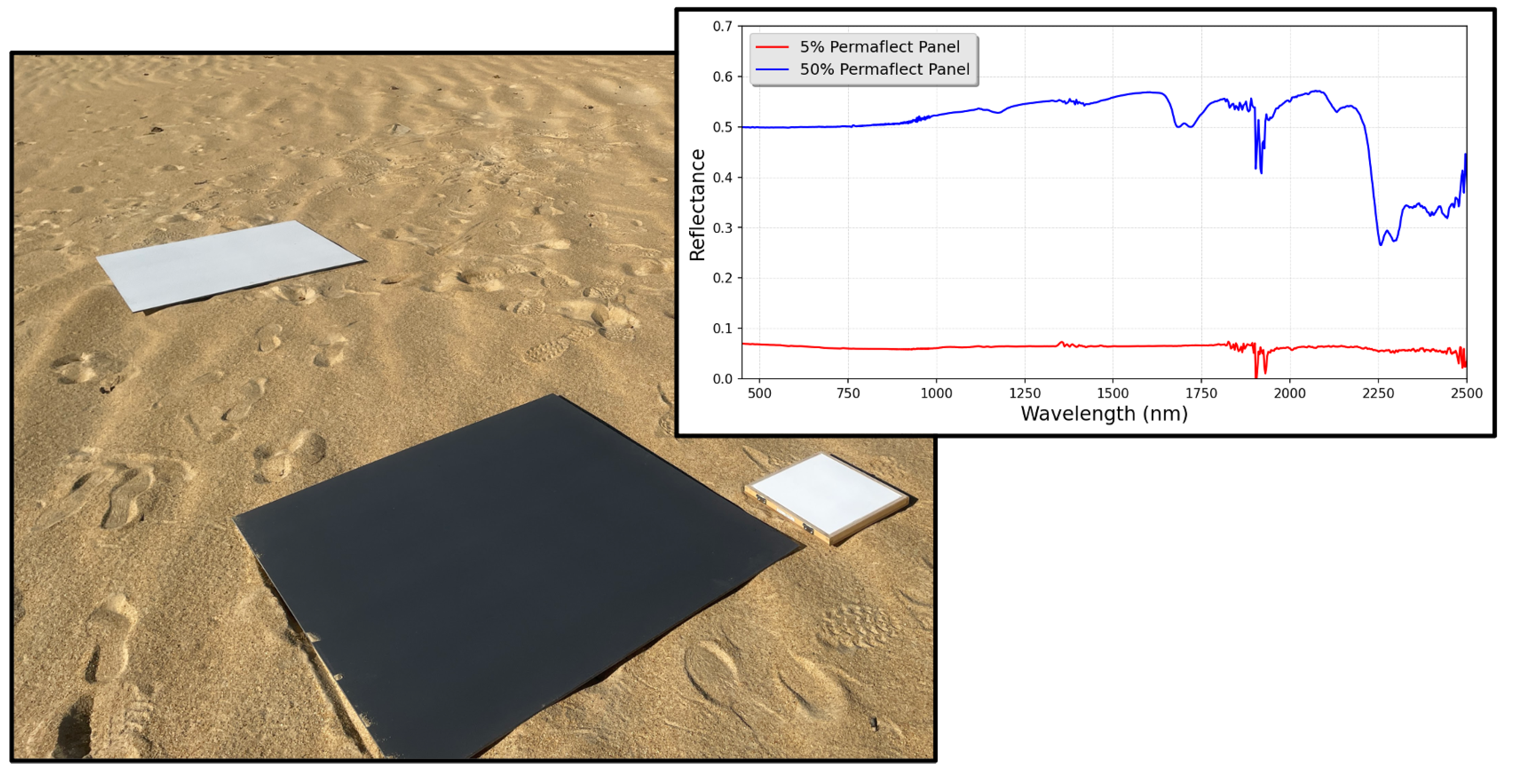
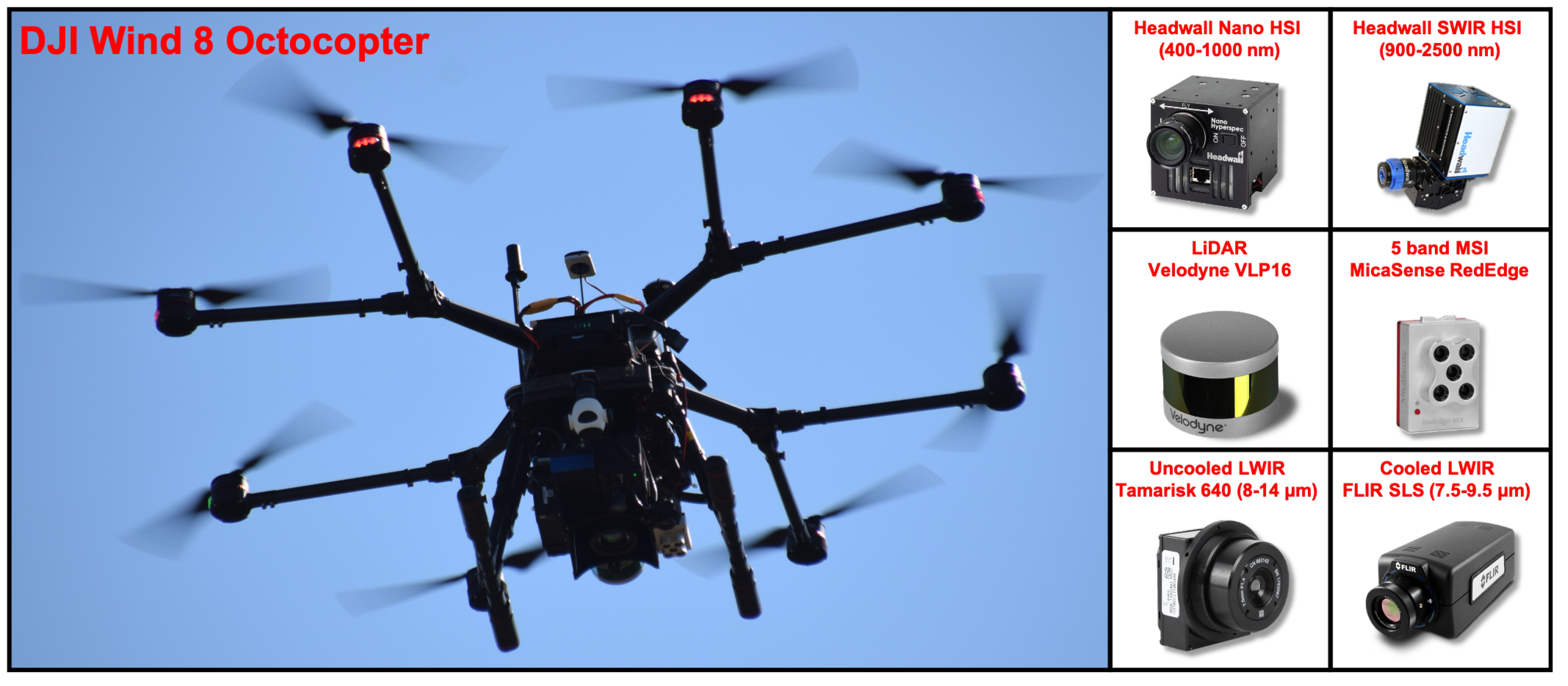


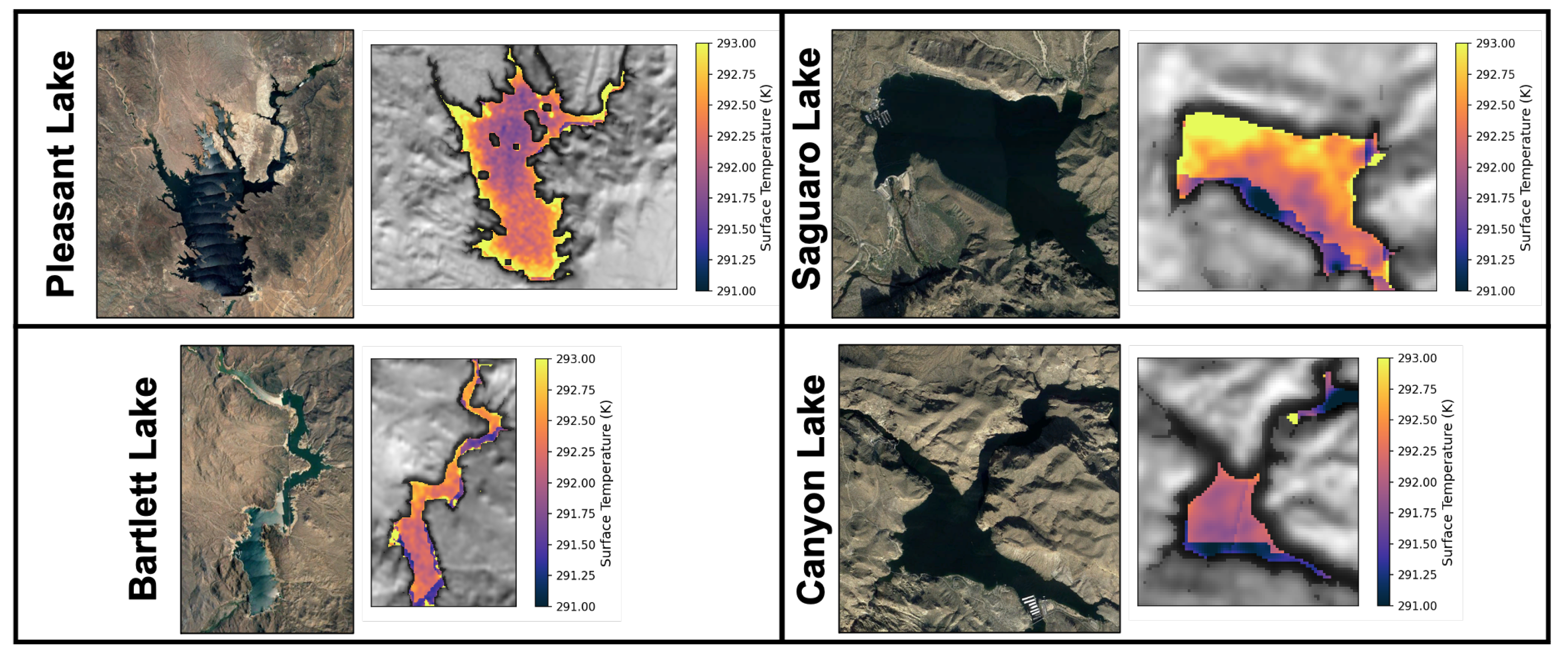
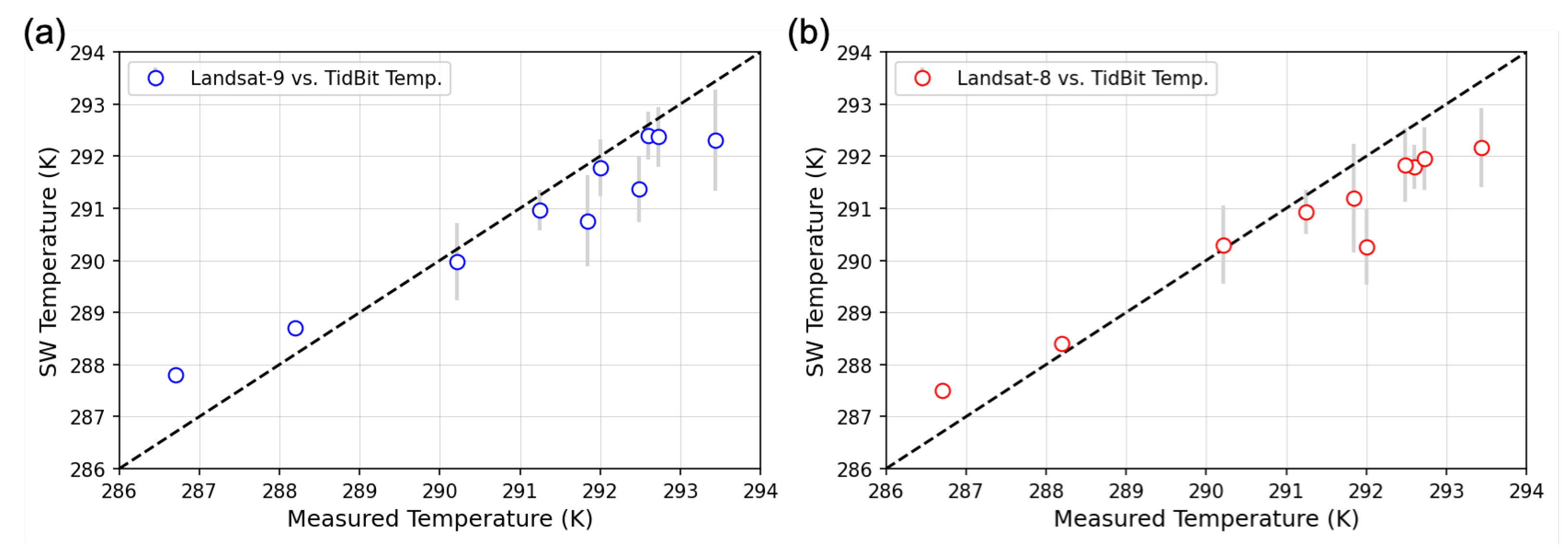

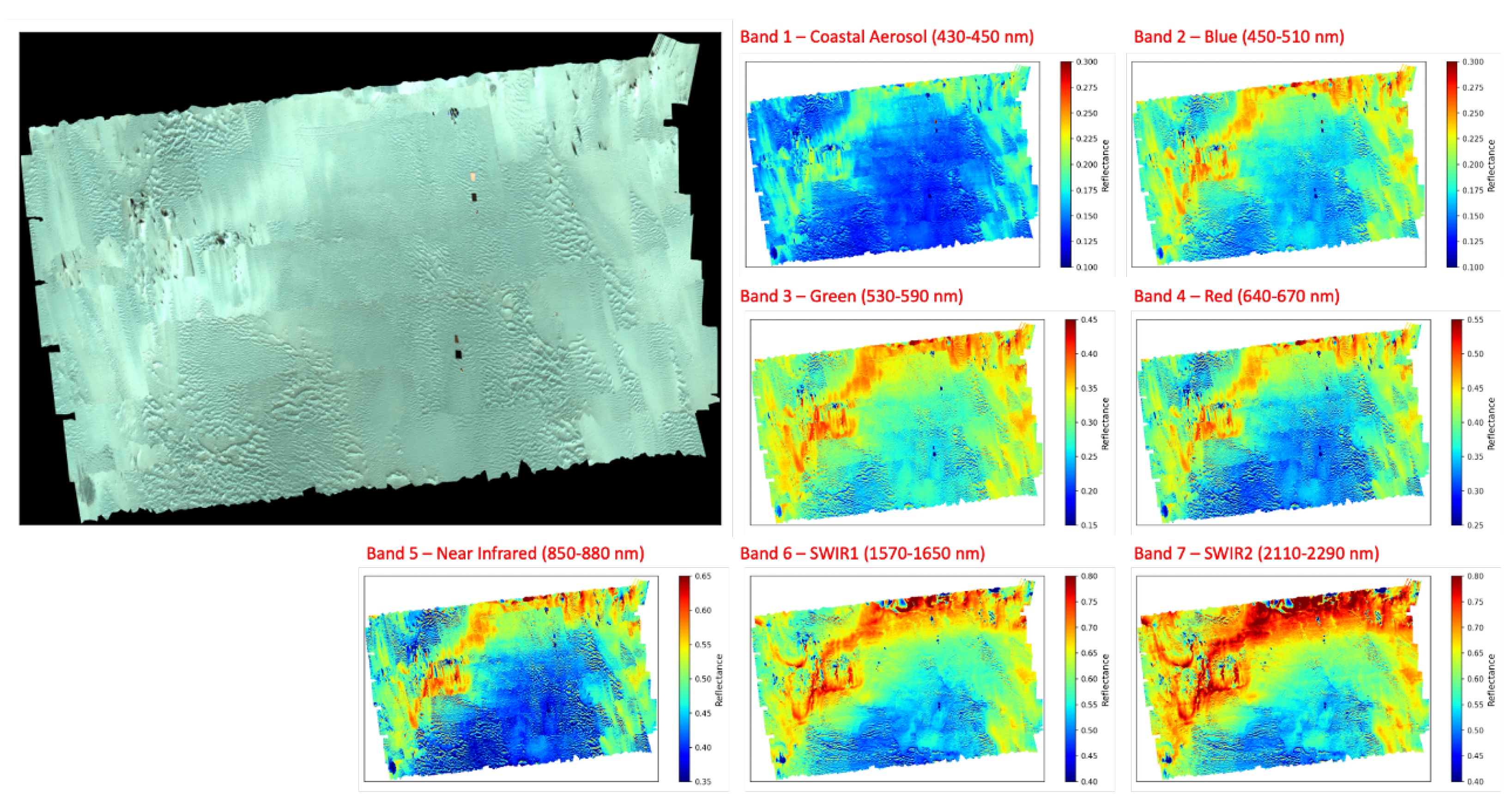


| Temperature (K) | NET (K) | Drift (%) | Absolute Uncertainty (%) |
|---|---|---|---|
| 288 | 0.011 | 0.070 | 0.032 |
| 303 | 0.017 | 0.058 | 0.437 |
| 318 | 0.032 | 0.437 | 1.019 |
| Error Metric | L8 SW (K) | L9 SW (K) |
|---|---|---|
| Mean Diff. (K) | 0.51 | 0.30 |
| Std. Dev. (K) | 0.70 | 0.67 |
| RMSE (K) | 0.87 | 0.74 |
| Site | UAS FLIR (K) | FTIR (K) | TidBit (K) | L8 SW (K) | L9 SW (K) |
|---|---|---|---|---|---|
| OBX Dunes | 289.9 | 290.3 | - | 291.8 | 291.9 |
| OBX Bay-side Water | 287.5 | - | 286.7 | 287.5 | 287.8 |
| OBX Ocean-side Water | - | - | 288.2 | 288.4 | 288.7 |
| Mean Diff. (K) | Std. Dev. (K) | RMSE (K) |
|---|---|---|
| 0.38 | 1.08 | 1.13 |
Disclaimer/Publisher’s Note: The statements, opinions and data contained in all publications are solely those of the individual author(s) and contributor(s) and not of MDPI and/or the editor(s). MDPI and/or the editor(s) disclaim responsibility for any injury to people or property resulting from any ideas, methods, instructions or products referred to in the content. |
© 2023 by the authors. Licensee MDPI, Basel, Switzerland. This article is an open access article distributed under the terms and conditions of the Creative Commons Attribution (CC BY) license (https://creativecommons.org/licenses/by/4.0/).
Share and Cite
Eon, R.; Gerace, A.; Falcon, L.; Poole, E.; Kleynhans, T.; Raqueño, N.; Bauch, T. Validation of Landsat-9 and Landsat-8 Surface Temperature and Reflectance during the Underfly Event. Remote Sens. 2023, 15, 3370. https://doi.org/10.3390/rs15133370
Eon R, Gerace A, Falcon L, Poole E, Kleynhans T, Raqueño N, Bauch T. Validation of Landsat-9 and Landsat-8 Surface Temperature and Reflectance during the Underfly Event. Remote Sensing. 2023; 15(13):3370. https://doi.org/10.3390/rs15133370
Chicago/Turabian StyleEon, Rehman, Aaron Gerace, Lucy Falcon, Ethan Poole, Tania Kleynhans, Nina Raqueño, and Timothy Bauch. 2023. "Validation of Landsat-9 and Landsat-8 Surface Temperature and Reflectance during the Underfly Event" Remote Sensing 15, no. 13: 3370. https://doi.org/10.3390/rs15133370
APA StyleEon, R., Gerace, A., Falcon, L., Poole, E., Kleynhans, T., Raqueño, N., & Bauch, T. (2023). Validation of Landsat-9 and Landsat-8 Surface Temperature and Reflectance during the Underfly Event. Remote Sensing, 15(13), 3370. https://doi.org/10.3390/rs15133370






